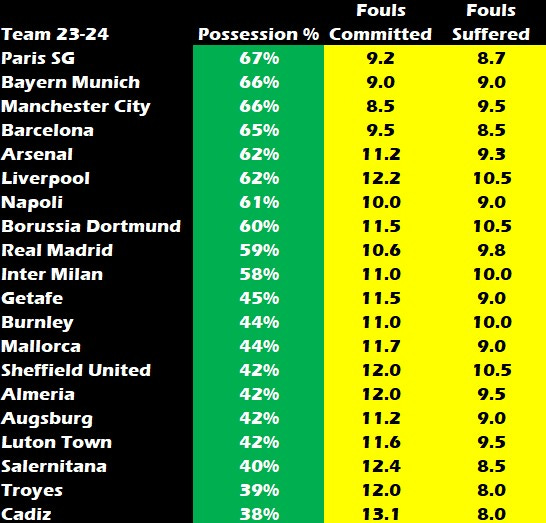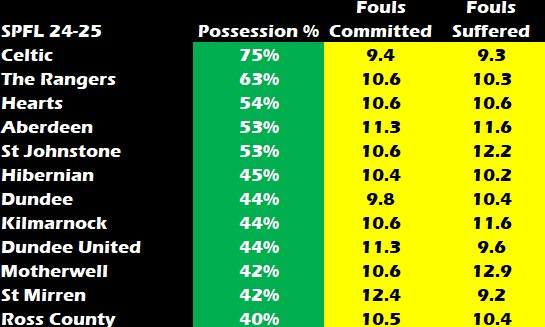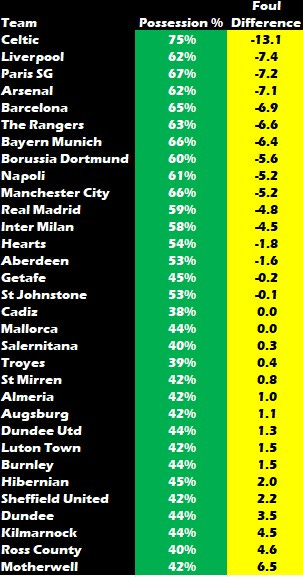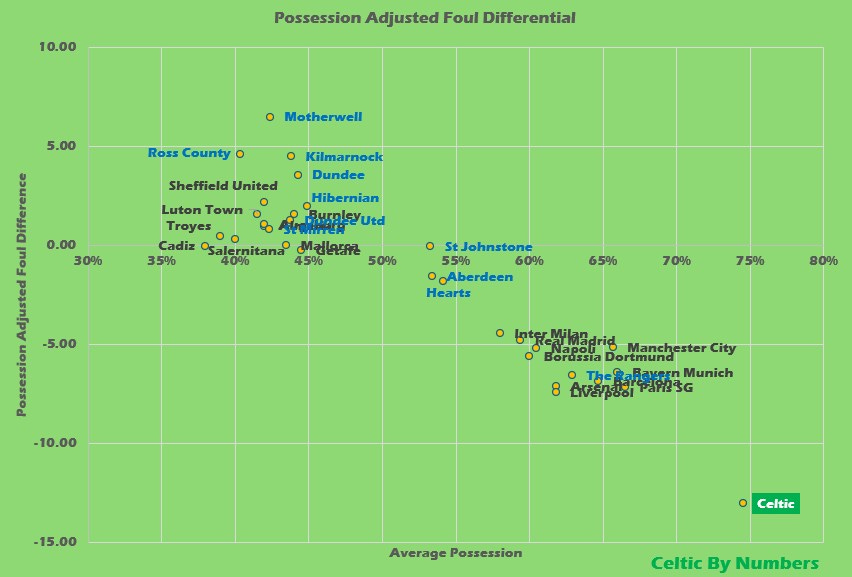The Humble Foul, Possession Adjustment, Foul Differentials and Room For Doubt
Is the humble foul the last redoubt for Scottish referees and their unfettered unconscious biases? Or is Celtic simply "normal" amongst high possession, high pressing sides?
90 minutes had elapsed by the time Don Robertson awarded Celtic their one and only foul of the match at home to Hibernian on Saturday.
Opta had the final foul count at 17 awards to Hibernian and one to the home side. A remarkable disparity. The ball was in play 56.84 minutes, and Celtic had what is a typical 75% possession. Meaning Hibernian had possession of the ball for 14.21 minutes. Celtic, therefore, committed 17 fouls in those 14.21 minutes – 1.19 fouls a minute. Even more remarkable, given that most of Hibernians’ possession was spent standing around deciding which of the multiple balls to use.
This differential of 16 fouls is not the most I’ve recorded, by the way. That was an infamous match at Pittodrie in October 2021 when keen betting enthusiast Bobby Madden awarded Aberdeen 27 fouls to 10 for Celtic, eight of them against hatchet man, errr, *checks notes*, Jota.
Kevin Clancy found a 16-foul differential in a match at Ross County in January 2015 – the count that day was 22 to six.
Matthew McDermid awarded one foul against St Johnstone in December 2024 in a 4-0 victory for Celtic at home.
So, these events are not without precedent.
The question is whether this can be considered “normal”.
Celtic fans do right to be suspicious. These pages have established with high degrees of statistical significance that one team was provided special protection against jeopardy during Crawford Allan’s reign of error. Clear patterns of assistance towards The Rangers skewed Scottish football for years.
However, since Allan’s ignoble departure and the promotion of the rather hapless Willie Collum as Head of Refereeing, there have been discernible changes to those patterns. Whilst the underlying culture and attitudes are likely unchanged, the transparency Collum has introduced with the YouTube outings of bad calls and the publication of the Key Match Incidents (KMI) report, has changed behaviours. No referee wants to be defrocked on YouTube.
Overall standards and performance of the part-time officials do not seem to have improved, but under the harsh scrutiny of public data, errors are now more normally distributed across all teams more or less equally. This is a big step forward for fairness, if not the quality of service.
But is the humble foul, never the subject of YouTube forensics nor ever to appear on a KMI report, the last bastion of unconscious bias? Football is a contact sport. Not all contact is a foul, and whether a line has been crossed between acceptable physicality and foul play is hugely subjective. In such grey areas does unconscious bias thrive.
Also, this debate needs to be taken above the level of mere counting. Tallying up fouls for and against and comparing card counts is oversimplistic and avoids some truths about the nature of football that need to be considered in any analysis.
The key question distils to this: Celtic is a possession-dominant team that aggressively deploys pressing and counterpressing strategies when the ball is lost. Is their profile of fouls awarded and conceded consistent with other clubs with similar styles in leagues, unlike Scotland, where every effort is made to remove doubt and unconscious bias from officiating?
Is Pressing and Fouling Linked?
Teams that press and counterpress aggressively (Liverpool under Jurgen Klopp, Leeds United under Marcelo Bielsa, early Thomas Tuchel at Chelsea) tend to commit a lot of fouls high up the pitch.
That’s because pressing relies on disrupting build-up quickly; tactical fouling is often used to prevent transitions when the press is broken. Teams that attack often, commit many players to those attacks, and aggressively press are vulnerable to counterattacks due to the space and relative lack of personnel in defensive shape.
Counterpressing in particular raises foul counts because it involves swarming the ball-carrier immediately after losing it.
Teams with 60–65% possession (Manchester City, Barcelona, Paris Saint-Germain) spend less time defending overall, so they naturally have fewer foul opportunities.
On a raw fouls-per-game basis, they often commit fewer fouls than reactive, low-block teams.
If we adjust for the amount of defending a team has to do (per opposition possession or per defensive action), high-possession, high-pressing sides usually foul at a higher rate than passive sides.
For example, Pep Guardiola’s Manchester City might commit ~9–10 fouls per match, but because they allow the opponent very few possessions, their fouls-per-opponent-possession defended is relatively high.
Low-block teams (e.g. Burnley under Sean Dyche) might commit ~11–12 fouls, but spread across far more opposition possessions, so the rate per defensive possession is lower.
Studies using StatsBomb and Opta data have found that:
· Pressing intensity (Passes Per Defensive Action, counterpressing recoveries) correlates positively with possession-adjusted fouling rates.
· Elite pressing teams like Klopp’s Liverpool or Bielsa’s Leeds United often ranked top in “fouls per opposition pass allowed.”
Passive, deep-block teams foul less per defensive opportunity, relying on shape rather than disruption.
So, teams that dominate possession and press aggressively tend to concede more fouls on a possession-adjusted basis (per defensive action opportunity) than low-press, deep-block sides. They commit fewer fouls overall (because they defend less), but when they do defend, they foul more frequently, using tactical fouls to sustain their press and prevent transitions.
I suggest Celtic resembles this profile.
Meaning, we need to allow for the fact that, in common with trends between high and low possession sides and high and low pressing sides, Celtic will foul more frequently on a possession-adjusted basis.
Comparative Study
Long story short, it is a fiddle to collate data across multiple leagues on a consistent basis.
Here are 20 teams from the “top five” leagues from the 2023-24 season that are a sample of “high” and “low” possession teams and their foul rates for and against.
Here is the same data for the SPFL from the 2024-25 season.
We can see a similar distribution from high to low, but Celtic are an outlier in terms of volume of possession, even compared to European behemoths like Manchester City.
Upon this raw data, we then need to sprinkle some analytical fairy dust. Assuming the ball is in play for no more than 60 minutes per game (reasonable for most of the top five leagues but a little high for Scotland), we possession-adjust the fouling rates so that we can see, relative to each team’s possession profile, what the foul count would look like had possession been equal.
This effectively equalises possession as a factor, and we can consider other factors such as pressing and counterpressing strategies.
We can then plot average possession percentage with the difference between fouls awarded and fouls conceded on a possession-adjusted basis.
If we plot it.
Celtic is a clear outlier, as 75% average possession might suggest. But also, in the possession-adjusted negative difference between fouls awarded and conceded.
This further illustrates that possession-dominant sides who press aggressively will concede more fouls on a possession-adjusted basis, and the clustering of the top European heavyweights confirms. The Rangers profile based on 63% possession is also consistent with this.
Sides with low possession concede fewer fouls when their defensive strategies are to sit deeper and press less aggressively.
There are two clear populations on that basis.
A couple of other observations.
One is that there is a concentration of Scottish clubs who appear to be most leniently treated – i.e. have a heavier positive profile of fouls awarded versus conceded. Those sides, in 2024-25, could also be characterised as the more physical in the division. I think this supports the notion James and I have raised many times on the podcast that, in general, referees in Scotland are more lenient when it comes to robust physical challenges.
Meanwhile, Celtic and The Rangers are penalised for perhaps more tactical, less robust challenges that stop opposition transitions in line with the trend amongst European playing-style peers.
However, even allowing for Celtic’s outlier possession average of 75% (the next highest in the sample is 67%), can the differential in fouls be solely explained by playing style?
Remember the dominant outworking of patterns of assistance: it wasn’t that The Rangers were constantly being rewarded with penalty after penalty or opposition sending offs for nothing. Yes, it seemed that on a relative basis. But patterns of assistance under Crawford Allan were characterised by the ABSENCE of jeopardy for The Rangers. It was penalties not awarded and sendings off not given that was the prevailing trend. It is much harder to critique something that didn’t happen than something that did. There is always the “seen them given” and “gave the referee a decision to make” defences, allowing plenty of scope for fence-sitting.
What characterises Celtic’s foul profile is, like on Saturday, the relative absence of fouls awarded against the opposition. Celtic gets 6.31 fouls in their favour a game on a possession-adjusted basis – the next highest in 2024-25 was 8.65 for The Rangers. The league average was 11.81.
Nearly all our analytical discussions come down to a judgment on attribution.
How much of Celtic’s outlier profile as regards fouls awarded versus conceded comes down to style of play? In this data set, there is a 0.91 correlation between possession and possession-adjusted foul difference – a very strong correlation, in other words. Clearly, this is impacting the foul differential to a significant degree.
Celtic has around 12% more possession than the next highest possession side in this sample (Paris Saint-Germain). Yet, there was an 82% higher foul difference between the sides.
Is the humble foul the last redoubt for Scottish refereeing? There is some room in the data for doubt on this.
And we are back to the point that Scottish refereeing does very little to remove that doubt for ALL fans of ALL clubs.






I did notice a couple of times yesterday that the referee waved play on after a foul by Hibs as Celtic still had possession , not sure that this would impact on the stats though
Interesting piece. Having watched the full game live yesterday, however, I cannot think of a single time when I thought we should have got a foul and we didn’t.
Which means Hibs defending of us was either brilliant or our attacking is so lightweight that it is easy enough to get the ball from us without any meaty dubious challenges needed.
But I hate this modern era of the opponent falling over the ball when our player gets near and getting the free kick to alleviate the pressure. But is it something we should be doing more off? Are opponents better at attracting fouls than we are? And this isn’t just SPFL, happens across Europe as well. Maybe we just aren’t savvy enough?